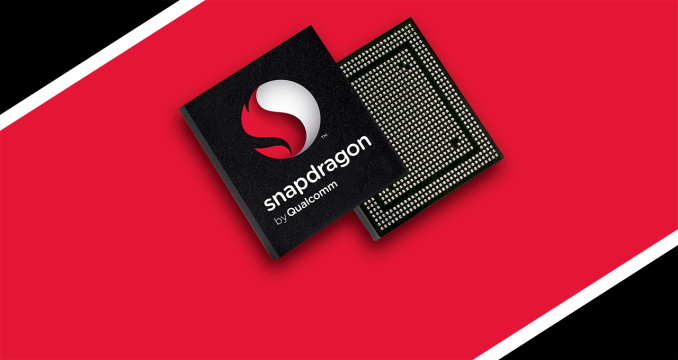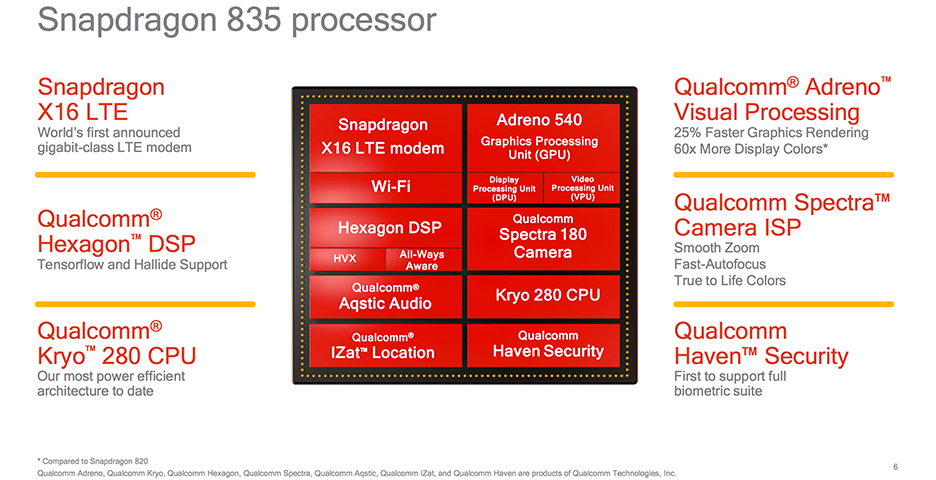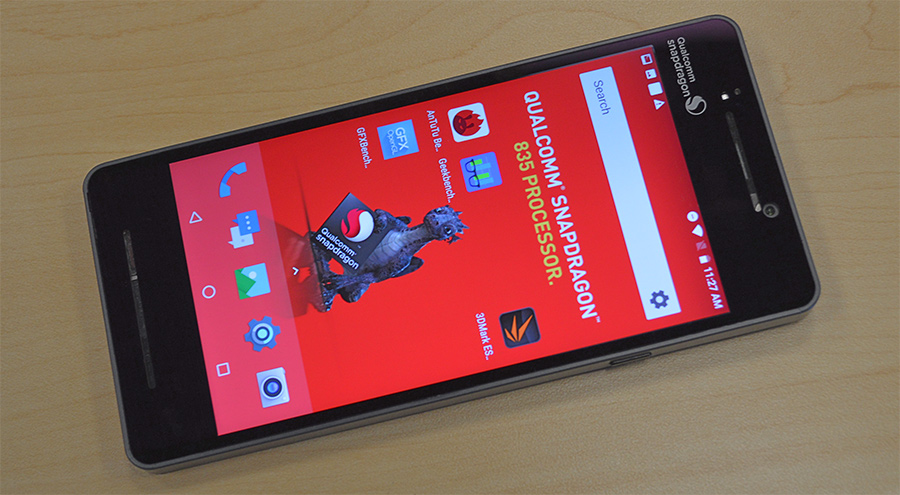The Qualcomm Snapdragon 835 Performance Preview
by Matt Humrick & Ryan Smith on March 22, 2017 4:30 AM EST- Posted in
- Smartphones
- Snapdragon
- Qualcomm
- Mobile
- SoCs
- Snapdragon 835
- Kryo

The Snapdragon 820 SoC was a significant milestone on Qualcomm’s roadmap. It was a solid improvement over the 808/810, delivering higher performance and efficiency, and became a commercial success, finding its way into the majority of flagship phones last year. More importantly, it heralded Qualcomm’s vision for mobile devices: heterogeneous computing. This meant new hardware—a much improved Hexagon 680 DSP that added single instruction, multiple data (SIMD) Hexagon Vector Extensions (HVX); Qualcomm’s first fully-custom 64-bit CPU core, Kryo, which focused on improving floating-point IPC; and an updated Adreno GPU with strong ALU performance—for enabling new software technologies and user experiences—artificial intelligence for smarter personal assistants, machine learning for object recognition, computational photography for better image and video quality, and new AR/VR experiences.
Snapdragon 835—now a part of Qualcomm’s Snapdragon Mobile Platform that includes all of the company’s mobile hardware and software—is an evolutionary product that builds on this vision. The greater than 3 billion transistor SoC is the first to use Samsung’s 10nm "10LPE" FinFET process, which reduces overall package size by 35% relative to Snapdragon 820. The new SoC’s CPU transplant and X16 LTE modem, which tops out at 1Gbps (Category 16) on the downlink, are the biggest changes, but most of the other blocks within the SoC have received at least minor updates too. For detailed information about all the changes and new features, you can read our Snapdragon 835 launch article.
| Qualcomm Snapdragon SoCs: Three Generations | |||
| SoC | Snapdragon 835 (MSM8998) |
Snapdragon 820 / 821 (MSM8996 / MSM8996 Pro) |
Snapdragon 810 (MSM8994) |
| CPU | 4x Kryo 280 Performance @ 2.45GHz 4x Kryo 280 Efficiency @ 1.90GHz |
2x Kryo @ 2.15GHz / 2.34GHz 2x Kryo @ 1.59GHz / 2.19GHz |
4x Cortex-A57 @ 2.00GHz 4x Cortex-A53 @ 1.50GHz |
| GPU | Adreno 540 @ 710MHz ? | Adreno 530 @ 624MHz / 653MHz | Adreno 430 @ 630MHz |
| Memory | 2x 32-bit @ 1866MHz LPDDR4x 29.9GB/s |
2x 32-bit @ 1866MHz LPDDR4 29.9GB/s |
2x 32-bit @ 1600MHz LPDDR4 25.6GB/s |
| ISP/Camera | Dual 14-bit Spectra 180 ISP 1x 32MP or 2x 16MP |
Dual 14-bit Spectra ISP 1x 25MP or 2x 13MP |
Dual 14-bit ISP 1x 21MP |
| Encode/Decode | 2160p30 (2160p60 decode), 1080p120 H.264 & H.265 |
2160p30 (2160p60 decode), 1080p120 H.264 & H.265 |
2160p30 (2160p60 decode), 1080p120 H.264 & H.265 |
| Integrated Modem | Snapdragon X16 LTE (Category 16/13) DL = 1000Mbps 3x20MHz CA, 256-QAM UL = 150Mbps 2x20MHz CA, 64-QAM |
Snapdragon X12 LTE (Category 12/13) DL = 600Mbps 3x20MHz CA, 256-QAM UL = 150Mbps 2x20MHz CA, 64-QAM |
Snapdragon X10 LTE (Category 9) DL = 450Mbps 3x20MHz CA, 64-QAM UL = 50Mbps 1x20MHz CA, 16-QAM |
| Mfc. Process | 10nm LPE | 14nm LPP | 20nm SoC |
In what has become an annual tradition going all the way back to Snapdragon 800, Qualcomm invited the media to its headquarters in San Diego for some feature demonstrations and limited testing using the company's Mobile Development Platform (MDP) devices. These are fully functional tablets or smartphones in a slightly oversized, utilitarian chassis used for hardware testing and software development. The MDP for Snapdragon 810 took the form of a tablet, while Snapdragon 820 came inside a large smartphone with a 6.2-inch display. This downsizing trend continues for Snapdragon 835, whose MDP/S is a smartphone with 6GB of RAM, a 5.5-inch 2560x1440 display, and a small 2850 mAh battery. The use of a smaller chassis is encouraging, because it has less mass and surface area to absorb and dissipate heat. This suggests a lower TDP for the 835, but we'll need to measure power consumption to be sure.
Because we only had a limited time for testing, we focused on running some basic CPU, GPU, and memory performance tests. Keep in mind that we were testing prototype hardware running pre-production software that resulted in a few hiccups. The condensed testing period also forced us to stray slightly from our usual testing methodology. Therefore, these numbers should be viewed as preliminary and could change by the time retail units begin shipping.












128 Comments
View All Comments
leexgx - Wednesday, April 5, 2017 - link
64bit has not gave them any more speed (even apple said 64bit did not affect speed), more due to cpu and IOS optimisation (just lets them use 4gb later on )melgross - Wednesday, March 22, 2017 - link
They are years ahead.zodiacfml - Wednesday, March 22, 2017 - link
Correct. Apple has the luxury with bigger chips/dies. Their dies are larger than Intel CoreGasaraki88 - Wednesday, March 22, 2017 - link
The A10 is still an ARM processor. They do their own tweaking of the hardware to make it good. They also have full control of the both the hardware and software stack so they can optimize them to work together efficiently.melgross - Wednesday, March 22, 2017 - link
Apple has an architectural license with ARM. They design their chips from the ground up. It's believed that they may have one with Imagination for the GPU as well.The advantage they have is that the OS developers work hand in hand with the hardware designers to optimize both the hardware and OS for each other. No one else can do that.
tuxRoller - Wednesday, March 22, 2017 - link
As others have said, apple's design has been made with very particular goals in mind. Going wider and slower is, normally, more power efficient than narrower and faster, assuming you can actually feed the beast. You pay the cost in silicon and yield, however.ET - Thursday, March 23, 2017 - link
Would be interesting to see Chrome results on all platforms. Using Chrome for Android and Safari for iOS is misleading. As the article said, Qualcomm's internal browser gets 280 in WebXPRT 2015, which trounces the iPhone 7's 208. (Though it's still slower in the other web benchmarks.)Achtung_BG - Wednesday, March 22, 2017 - link
die size maybe less the 80mm2?prime2515103 - Wednesday, March 22, 2017 - link
Just a suggestion...Since this is a preview of a chip, and not an actual phone review, I think it would be helpful if the model of the chip in each phone be put next to them in the charts instead of just the S7. It's quite inconvenient to have to go look it up while in the middle of reading the article.
With that said, I've noticed that mobile chips tend to vary a more widely from generation to generation than desktop parts seem too (they loose ground in certain areas, with big drops in the 20%+ range).
Is this a result of a compromise for power reduction, or are they just not as good at this yet as Intel?
StevoLincolnite - Wednesday, March 22, 2017 - link
+1Would be also great if we could include other SoC's like Tegra.